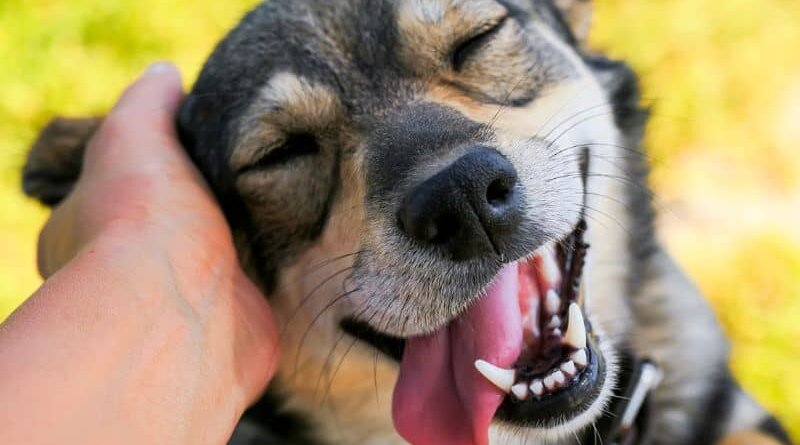Are Dogs Ticklish? Are You Scratching An Itch Or Tickling?
This post may contain affiliate links. We may earn money or products from the companies mentioned in this post.
Today’s question: Are dogs ticklish?
Dogs are ticklish in the same way that most mammals are ticklish.
Essentially, humans and other mammals developed the ability to detect a light movement across their skin which told their brains that there was an insect on them and to brush it off.
Dogs have the ability to detect the light sensations on their skin that can mean a flea or tick is moving through their fur, and they respond to these sensations by rolling in the grass or scratching themselves.
When you tickle your dog, you are mimicking these sensations.
Sometimes this ticklish sensation can be pleasant, and sometimes your dog may not enjoy it.
Dogs are very unique just like humans, and to understand how your dog responds to being tickled, you will need to pay close attention to your dog’s behavior to judge their level of enjoyment.
To understand more about
- What tickling actually is…
- Why dogs are ticklish…
- Which spots they are most ticklish in…
- Whether they actually enjoy being tickled…
Keep reading to find out!
What Does It Mean To Be Ticklish?
You may be ticklish, or you may not–this is because having the ability to be tickled is person-specific.
Some people are incredibly ticklish, while others barely feel anything no matter how sneaky you are in tickling them.
Some of us are ticklish in certain spots, while others aren’t.
There are two different kinds of ticklish feelings: knismesis and gargalesis.
Almost all mammals (including humans and dogs) can feel a knismesis tickle.
However, gargalesis tickling seems to be strictly for humans and some great apes for enjoyment purposes, while it is a purely reflexive reaction for dogs.
Let’s take a closer look at what these two types of tickles tell us.
Knismesis
Knismesis is the sensation of a bug walking over you or a piece of hair on your shoulder.
It is an activation of the pressure sensors in the skin.
You are able to make yourself feel this sensation by lightly brushing your fingers over your skin. If you try this, you’ll feel a slight tickle and may even get goosebumps.
In short, knismesis is an evolutionary response telling you that there is something on you that doesn’t belong there.
Gargalesis
Gargalesis is the intense, laughter-inducing, tear-causing, pants-wetting ticklish sensation.
Others can make you feel the gargalesis ticklish sensation, but you cannot do it to yourself because your brain is just too smart for that!
Gargalesis is the activation of the pressure and the pain receptors in the skin.
This is why you may feel panicked and scared when someone tickles you. It’s because your brain is telling you they are causing you pain, and you need to run away.
This is why some people enjoy being tickled and others dread it.
Can Dogs Be Ticklish?
Dogs are ticklish!
Dogs can feel knismesis!
You may see them go from completely calm and relaxed to quickly giving their ear a scratch or their hind leg a nibble, and then they go back to being calm and relaxed.
This is because your dog feels the same thing you feel when an ant crawls over your foot, a hair blows across your neck, or a loose thread unexpectedly touches the back of your leg.
Dogs can also feel gargalesis!
You are able to tickle your dog in the same way that someone else is able to tickle you by activating their pressure and pain receptors at the same time.
Your dog may have a funny reaction, they may lay back and love it, or they may try to run away.
It is important for you to pay attention to their behavior in order to determine whether you should continue to tickle them.
Do Dogs Enjoy Being Tickled?
Dogs are unique as humans. Some humans love being tickled and chased around, while others may dissolve into tears and shout for you to stop.
Dogs can have the same feelings as well. Unfortunately, they cannot actually tell us to stop or to carry on.
This is why knowing your dog’s behavior and signs of distress is so important.
If you are able to understand your dog’s attempt to communicate with you, then it will lead to a happier dog and a happier relationship between you two.
The knismesis ticklish sensation is often an irritation to dogs, as they most associate it with fleas and ticks, or loose hair falling out. If you see your dog scratching at specific spots, or constantly flicking their skin or ears without being tickled, then have a look for the crawling culprits.
If you are familiar with this behavior in your dog and they perform these actions while you are tickling them, then they may not enjoy the sensation and you may just be irritating them.
In this case, tickling your dog may be causing them stress and anxiety.
Whether or not your dog enjoys the gargalesis ticklish sensation is a little bit easier to gauge, as their reaction will be far more obvious.
As I previously mentioned, the gargalesis tickling reaction is completely involuntary because it is the activation of the pressure and pain receptors.
Some dogs may lay back and completely submit to the tickles and be quite happy to receive them.
However, if your dog moves away from your hand, wrinkles its lips, flattens its ears, or tries to nibble your hands, then they are not enjoying your attention and would like to get away.
The reaction is completely individual to the dog, so you’ll need to pay careful attention to how they react.
Which Parts Of A Dog Are Most Ticklish?
The most sensitive parts of your dog’s body will be the most ticklish parts. Some of the most common ticklish places of dogs are:
- Their paws
- At the base of their tails
- Their bellies
- Along their sides
- Behind their ears
- In their armpits
- Along their jaws
Where your dog is most ticklish is also an individual thing. Some dogs, for example, may have more sensitive paw pads than others.
If your dog appears to enjoy tickles, then find out which are their favorite spots and which spots don’t elicit any response.
The base of the tail, where it meets the back, is one of the areas on a dog’s body that will almost always get a response.
Your dog will most likely push its butt up towards you. This is not necessarily a tickle response.
They may be responding to this because you are actually stimulating their nerves where their spine extends into their tail.
Their movement in pushing their butt up is then an involuntary response and should not always be seen as a sign of enjoyment.
Also, we’ve unfortunately noticed that fleas sometimes congregate in the base of the tail. If you’ve ever had flea problems you may notice your dog biting at the base of his tail.
Why Do Some Dogs Kick Their Legs During Belly Rubs?
Some dogs kick their legs when they receive belly rubs or scratches around their ears or along their jaws.
Their legs will thump around almost as if they are trying to scratch themselves.
They may end up scratching themselves, or they may just tap dance away during the good scratches.
It looks a bit funny to us, and we always try to find ‘that spot’ again to get them thumping away.
However, it is important to note this is a completely involuntary response on their part, and it may not be too kind to continuously find ‘that spot’ for them.
Their legs start kicking or thumping because their brain is telling them that something is irritating them and they should remove it.
They are responding to the knimensis ticklish feeling I spoke about earlier.
While it may look funny to us humans and you think you are giving them the best tickles, it’s not always a good time for them.
Imagine having the feeling of an ant crawling in your armpit but no matter what you do, you can’t seem to get rid of the itch!
That is what it may feel like for your dog.
Look out for other signs of enjoyment or distress when they respond this way to tell whether they are enjoying it or not.
If their tongues are hanging out of their mouths or they are otherwise calm, then they could be okay with the feeling.
However, if their ears are flat, their eyes are wide and rolling, their muzzles are wrinkled, and they are trying to move away, then they may not be having a good time.
When scratching my own dogs I’ve always noticed the foot thumping. Each dog had a different scratch spot that would elicit this response.
Luckily every dog that did the foot thumping didn’t seem to mind the scratching/tickling. However, I am definitely more mindful of their response now that I know it’s not something all dogs enjoy.
Do Dogs Laugh When They Are Tickled?
Humans and other great apes will laugh or appear to laugh when they are experiencing gargalesis tickles.
This is often an involuntary response, and scientists are not quite sure why it happens at all, especially considering being tickled isn’t always a pleasant thing.
Unlike humans, dogs cannot laugh. Laughing doesn’t mean anything to dogs and it isn’t in their ability to laugh or respond in a humorous way.
However, you may think that they are laughing when being tickled because they open their mouths wider and make some noisy breaths.
This isn’t laughing; it’s a type of panting. The dog is not in control of it in the same way humans aren’t always in control of their laughter when being tickled.
While this is an involuntary response, it could be an indication that your dog is receiving too much stimulation, and you should stop tickling them.
As I have already mentioned, pay attention to your dog’s body language and behaviors while you are interacting with them because they don’t have the words to say, “Please stop tickling me!”
FAQs About Dogs Being Ticklish…
Are puppies more ticklish than older dogs?
A puppy’s skin is generally more sensitive than an older dog’s skin, so they will be more susceptible to tickles.
As your dog ages, you may think that they have grown out of their ticklish phase or lost their “ticklish spot.”
What is actually happening is your dog’s skin has become less sensitive as they have gotten older and no longer feel the same gargalesis tickles the way they used to.
Why does my dog try to bite my hand when I tickle them?
Sometimes when you are playing with your dog, especially a puppy, they may nibble on your hands or hold them in their mouths.
This is all part of play fighting. However, this is very different if they try to bite you or nibble your hands while you are tickling them.
Your dog is trying to communicate to you that they are not having fun with the tickle time.
The part of their body that you are tickling may be very sensitive, or your dog may be feeling overwhelmed with the sensation and wants you to stop as soon as possible.
Is tickling my dog the same as scratching or petting them?
Tickling is not the same thing as scratching or petting your dog. Scratching or petting your dog is a soothing feeling for them.
It is a calm and steady pressure applied to their skin and does not elicit a stress response.
Tickling your dog, on the other hand, is a more erratic pressure that is not intended to soothe or calm them.
Their response to the tickling is involuntary and very often a stress response.
Wagging Away On Whether Dogs Are Ticklish
To sum up, dogs are ticklish!
They respond to knismesis tickles as well as gargalesis tickles in similar ways to humans, minus all the laughter.
They have an involuntary response to the stimulation of the pressure and pain receptors in their skin.
Some dogs may enjoy the ticklish sensation, and some may not; it is a very individual experience, just like with humans!
To be a responsible tickler, pay attention to your dog’s behavior and actions while you are tickling them.
Stop tickling them if they try moving away from your hand, whine, flatten their ears, or wrinkle their muzzle.
Remember, their actions are their words, and you need to listen carefully!
Have you tried tickling your dog?
How does your dog respond to being tickled?
Tell us about your experiences in the comment section below.
Save To Pinterest
Top Picks For Our Puppies
- BEST PUPPY TOY
We Like: Calmeroos Puppy Toy w/ Heartbeat and Heat Packs – Perfect for new puppies. Helps ease anxiety in their new home. - BEST DOG CHEW
We Like: Bones & Chews Bully Sticks – All of our puppies love to bite, nip, and chew. We love using Bully Sticks to help divert these unwanted behaviors. - BEST DOG TREATS
We Like: Crazy Dog Train-Me Treats – We use these as our high-value treats for our guide dog puppies. - BEST FRESH DOG FOOD
We Like: The Farmer’s Dog – A couple months ago we started feeding Raven fresh dog food and she loves it! Get 50% off your first order of The Farmer’s Dog.
Check out more of our favorites on our New Puppy Checklist.




